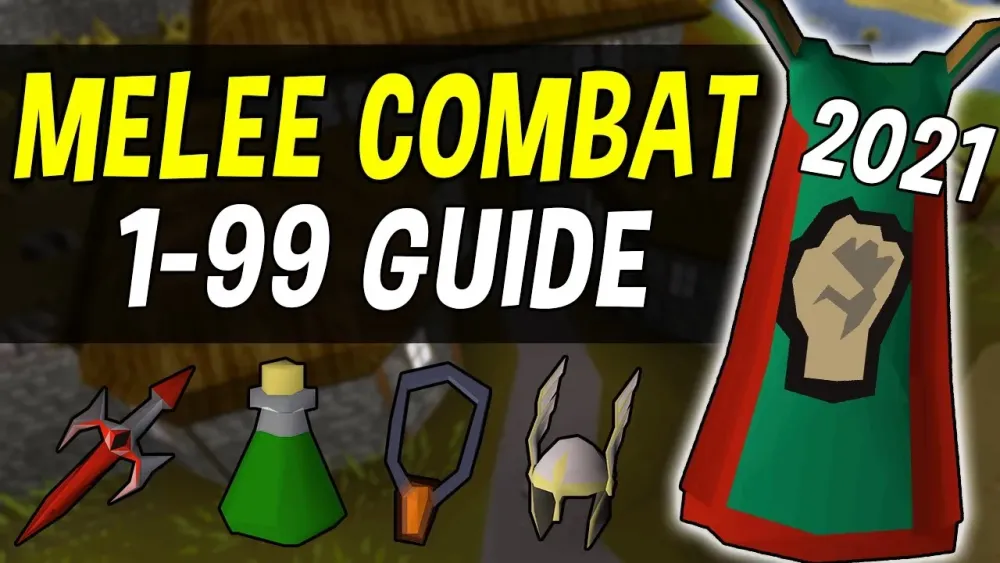Your cart is empty
Ultimate Guide to Free-to-Play OSRS Melee Training

Melee training in Old School RuneScape (OSRS) is a fundamental aspect of gameplay, allowing players to engage in combat effectively while progressing their skills. In the free-to-play (F2P) version of OSRS, players can participate in melee training to improve their Attack, Strength, and Defence stats. Understanding the mechanics and optimal methods for training melee skills can significantly enhance a player’s experience and efficiency in the game. This guide will explore the essential aspects of melee training in OSRS, focusing specifically on free-to-play options available to all players.
Melee training in the free-to-play version of OSRS offers numerous benefits that enhance both gameplay and character development. Firstly, melee skills provide players with a reliable combat style, allowing them to engage in more challenging encounters and defeat tougher monsters. By focusing on melee, players can achieve higher damage output, particularly when using powerful weapons like the black scimitar or the two-handed sword, which are accessible even in the F2P environment.
Additionally, training melee skills unlocks various combat strategies. Players can adapt their approach based on their strengths, choosing to specialize in Attack for accuracy, Strength for damage, or Defence for survivability. This flexibility allows players to tailor their gameplay experience to their preferences and style. Moreover, as melee skills improve, players can tackle quests and activities that require higher combat levels, expanding the content available to them.
Another significant advantage of melee training in F2P is its cost-effectiveness. Unlike some other training methods, melee training primarily relies on equipment that is either free or easily obtainable. Players can use basic gear such as bronze or iron weapons and armor, which can be upgraded quickly as they progress, making it an accessible training method for new players without the need for extensive financial resources.
Furthermore, melee training in F2P helps in gaining valuable experience points (XP) in combat, which is crucial for leveling up and unlocking new capabilities. Increased combat levels make it easier to handle high-level monsters and participate in group activities, including boss fights in the future when players transition to the members’ area. This training also contributes to overall account progression, as higher combat stats are essential for playing effectively in both F2P and P2P environments.
In summary, melee training in the free-to-play version of OSRS is a powerful tool for character development. It enhances combat effectiveness, provides flexibility in gameplay, is economically viable, and contributes significantly to overall game progression. Players who invest time in melee training will find themselves better equipped to face the challenges of Gielinor.
Best Locations for Melee Training

When it comes to training your melee skills in OSRS, choosing the right location is crucial. The ideal spot should offer a good balance of experience per hour and safety from aggressive monsters. Here are some of the best locations for Free-to-Play (F2P) melee training:
- Al Kharid Scorpion: Located just south of Al Kharid, the scorpions here are non-aggressive and provide decent experience. They have low defense and hit points, making them easy targets for training.
- Sand Crabs: While technically in the members’ area, the nearby F2P beaches can serve as a decent alternative for lower levels looking to train against crabs. They have high hit points and are non-aggressive, allowing for longer training sessions.
- Goblins: Found in several locations including the Goblin Village and south of Falador, these monsters are great for lower levels. They’re easy to defeat and drop some basic loot.
- Chickens: Located near Lumbridge, chickens are an ideal starting point. They have low combat levels and will not pose a threat, making them perfect for beginners.
- Hill Giants: If you’re a bit more advanced, Hill Giants in the Edgeville Dungeon can be an excellent choice. They provide good experience and drop big bones, which can be valuable for prayer training.
Make sure to consider your combat level and the type of gear you have when selecting a training location. Always keep an eye on your health and be prepared to retreat if you find yourself in a tight spot!
Recommended Gear for F2P Melee Training

Your gear plays a significant role in how effective your melee training will be. Using the right equipment can enhance your damage output and overall experience rates. Here’s a rundown of the best F2P gear options for melee training:
| Slot | Recommended Gear | Notes |
|---|---|---|
| Weapon | Black Scimitar | The black scimitar offers a great balance of speed and strength for F2P players. |
| Helmet | Steel Full Helm | Provides good defense and is relatively easy to obtain. |
| Body | Steel Platebody | Offers excellent protection but can be heavy, affecting your attack speed. |
| Legs | Steel Platelegs | Complement the steel platebody for high defense. |
| Boots | Steel Boots | Provide a small defense bonus without significant weight. |
| Amulet | Amulet of Power | Increases overall stats and is easy to craft. |
| Shield | Steel Kiteshield | Offers strong defense, especially against melee attacks. |
Remember to keep your gear upgraded as you progress in levels. Good equipment not only improves your combat efficiency but also enhances your overall gameplay experience.
Efficient Training Methods and Strategies
Training melee in OSRS (Old School RuneScape) can feel overwhelming, especially when you want to make the most of your time. Here are some efficient methods and strategies to help you level up quickly and effectively.
1. Choosing the Right Location: The first step to efficient training is picking the right spot. Here are some great locations:
- Sand Crabs: These have high hitpoints and are perfect for training with minimal interference.
- Giant Spiders: A good option, especially for lower levels, found in various dungeons.
- Hill Giants: They drop valuable items like Big Bones, making them a two-for-one deal.
2. Using the Best Gear: Gear matters! Make sure to equip:
- Best-in-slot weapons: Start with bronze or iron, then upgrade to steel, then mithril, and so on.
- Defensive armor: Keep your defense up with armor that boosts both your attack and defense stats.
3. Train with Friends: Melee training can be more efficient and fun with friends. Teaming up can help you tackle tougher monsters and share valuable drops.
4. Utilize XP Boosts: Consider using temporary boosts like Prayer Potions, Super Strength Potions, or Experience lamps to maximize your training sessions.
By following these strategies, you can ensure that your melee training is both efficient and enjoyable!
Understanding Experience Rates and Levels
In OSRS, understanding experience rates and how they relate to your levels is crucial for effective training. Let’s break this down.
1. Experience Points (XP): Every action in the game provides experience points. For melee training, you gain XP by:
- Dealing Damage: Each hit on a monster earns you melee XP.
- Using Abilities: Special attacks or abilities can give you bonus XP.
2. Experience Rates: Experience rates vary based on your combat level, the monster you’re fighting, and your gear. Here’s a quick table to illustrate typical XP rates:
| Monster | Combat Level | XP per Hour |
|---|---|---|
| Sand Crab | 1-10 | 30,000 |
| Giant Spider | 10-30 | 50,000 |
| Hill Giant | 30-50 | 70,000 |
3. Leveling Up: Each melee level requires more XP than the last. Here’s a simple breakdown of required XP:
- Level 1-10: 83 XP per level
- Level 10-30: 250 XP per level
- Level 30-99: 10,000 XP per level (after level 92, it gets significantly higher)
By understanding these experience rates and leveling requirements, you can set realistic goals and track your progress efficiently as you work towards maxing out your melee skills!
Common Mistakes to Avoid in Melee Training
Melee training in Old School RuneScape (OSRS) can be a rewarding experience, but it’s easy to fall into some common pitfalls that can slow your progress. Here are a few mistakes to avoid:
- Neglecting Equipment: Always ensure you’re using the best equipment available for your level. Wearing outdated gear can significantly hinder your efficiency.
- Ignoring Quests: Some quests provide valuable experience and unlock better training methods. Don’t overlook them; they can make a big difference in your training speed.
- Skipping Prayer: Using Prayer during training can greatly enhance your survivability and efficiency. Make sure to use prayers like Protect from Melee and Ultimate Strength as needed.
- Overlooking Potions: Potions such as Super Strength or Super Attack can boost your stats significantly. Don’t forget to stock up on these before starting a training session.
- Not Using Food Wisely: Always have food on hand. Eating at the right time can keep you training longer without the need to stop and heal.
- Focusing Solely on Combat: Remember to balance your melee training with other skills. Skills like Agility can improve your overall gameplay experience.
- Ignoring the Game’s Mechanics: Understand how hitpoints, damage calculations, and combat styles work. This knowledge will help you train more effectively.
By avoiding these common mistakes, you can ensure that your melee training is as efficient and enjoyable as possible. Remember, learning from others’ experiences can save you time and frustration!
Conclusion and Next Steps
Congratulations on reaching the end of this ultimate guide to free-to-play melee training in OSRS! By now, you should have a solid understanding of effective training methods, gear recommendations, and common pitfalls to avoid. Here’s how you can proceed:
- Assess Your Current Level: Take a moment to evaluate where you stand in your melee training. This will help you identify which areas need improvement.
- Set Goals: Define specific, achievable goals for your melee training. Whether it’s reaching a certain combat level or mastering a specific weapon, having a target will keep you motivated.
- Join a Community: Engage with the OSRS community through forums or social media. Sharing experiences and tips with other players can enhance your training process.
- Experiment with Different Locations: Don’t be afraid to try out different training spots. Each location offers unique challenges and opportunities for experience gain.
- Stay Updated: Keep an eye on game updates and patch notes. Changes to the game mechanics or new content can impact your training strategies.
By following these next steps and applying what you’ve learned from this guide, you’re well on your way to becoming a melee powerhouse in OSRS. Happy training!

